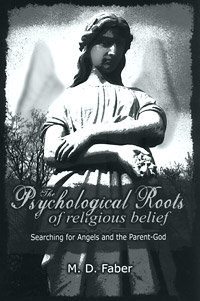
In this week’s eSkeptic, Kenneth W. Krause reviews The Psychological Roots of Religious Belief: Searching for Angels and the Parent-God by M.D. Faber (Prometheus Books, New York, 2004, ISBN 1591022673).
Kenneth W. Krause lives with his wife Cindy, along the Mississippi River in Wisconsin. He has earned degrees in Law, History, Literature, and Fine Art.
God the Father
a book review by Kenneth W. Krause
“Surely infantilism is destined to be surmounted,” wrote Sigmund Freud in his 1927 The Future of an Illusion. “Men cannot remain children for ever; they must in the end go out into the ‘hostile life.’ We may call this ‘education to reality.’” Freud, of course, was referring to the “infantilism” of religion — or as he so bluntly labeled it, “the universal obsessional neurosis of humanity.”
In The Psychological Roots of Religious Belief, M.D. Faber (Professor Emeritus of English Language and Literature specializing in literature and psychology at the University of Victoria, British Columbia, and former Special Fellow at the National Institute of Mental Health in Washington D.C.) takes issue with Freud’s ultimate conclusion. In the religious context, men and women apparently can and often do remain “children” forever, thanks in large measure to Abrahamic monotheism’s reliance on the omnipotent “Parent-God.”
Faber affirms that we are born fundamentally free from religious predilections, liberated to pursue a reasoned, constructive, and cooperative existence. How is it, then, that throngs of us slump into the swift stream of monotheistic superstition at every widening bend to be whisked away, perhaps forever, like so much like loose sand, despite our natural tendency toward firmly-grounded, rational thought? What is it about the human experience following the moment of birth that renders us so vulnerable to the Parent-God’s charms?
According to D. Andrew Kille, former pastor and lecturer in psychology and spirituality, and the author of “The Bible Made Me Do It” (in The Destructive Power of Religion, ed. J. Harold Ellens, Praeger Publishing, 2004), “Psychologists of religion have long recognized the close connection between early childhood development and later religious images and behavior. In the earliest experiences of mother and care lie the roots of God images and emotionally charged attitudes and reactions to spirituality and religious thinking.” Such is the general theme of Faber’s book, a theme he argues quite convincingly and in copious detail.
According to Faber, the caregiving parent begins laying the groundwork for the child’s eventual religiosity shortly after birth during what Faber calls the “basic biological situation.” Over and over, literally thousands of times per year, the needful infant cries out for and immediately receives nourishment, warmth, comfort, and care from the apparently omnipotent parent, usually the mother. The infant’s crying, or supplication, in response to “crises” constitutes “proto-prayer.” The omni-benevolent and all-powerful mother, in turn, becomes the child’s “proto-deity.”
According to Faber, “The basic biological situation gives rise at the implicit, unconscious level to the perceptual, emotional ‘scheme’ from which emanates our deepest emotional longings and perceptual inclinations.” The pattern of supplication and provision becomes internalized, literally rooted into the neural fabric of the child’s brain. Like muscles, synaptic connections grow stronger after repeated use. The pattern becomes permanently imprinted into unconscious memory. Faber identifies this process as “mnemonic priming” for eventual “mapping” onto the religious narrative and projection onto the illusionary Parent-God.
In most cases, neither the child nor the parent will ever comprehend what has occurred. The process is an entirely implicit one, relegated to the realm of what Freud dubbed “infantile amnesia.” Later in life, in response to external religious stimuli, for example, these implicit memories of the basic biological situation will be cued, played, and repeated as efficiently as can be: “The religious realm into which the child gradually enters mirrors unconsciously, associatively, perceptually, and affectively the presubjective ‘reality’ that the child has been internalizing and installing neurally as the basis of his gradually emerging identity. The religious realm, in two words, corresponds implicitly to the child’s mind.”
During the earliest stages of development, the child conceives of no existence apart from its parent. It finds an image of itself only in the caretaker, and thus, it participates in the world only through the caretaker. “The child,” writes Faber, “cannot at this stage say to the parent, ‘You misunderstand me,’ because no ‘me’ exists apart from the parent’s understanding. Thus the ‘reality’ of the caregiver does not become a ‘reality’ for the child; it becomes the only ‘reality,’ the only ‘place’ in which he has existence.” As such, the child attributes the provision of care and security not to the mother alone, but to itself as well. It is the child’s heady estimation of its own omnipotence, then, that marks the “symbiotic phase,” which peaks in intensity at about six to nine months.
Thereafter, as the child embarks on the process of separation from the caregiver, it will begin to implicitly suffer the terrifying loss of worldly hegemony. “This movement away,” writes Faber, “is attended by powerful anxiety and by the irrational wish to have it both ways: separateness and symbiotic union.”
During what some psychologists identify as the “practicing phase,” eleven to fifteen months, the infant becomes more engaged in its burgeoning mental and physical world. Even so, it always returns to the mother for emotional refueling. At about thirty months, during the “rapprochement phase,” the separation process culminates; the child begins to fully comprehend the solitary nature of its existence. The toddler will first demand attention from its parental caregiver and then turn to other persons, including the father, and to transitional objects, including toys, pets, blankets, etc., in an attempt to maintain emotional constancy.
Some have characterized the child’s separation from the parental caregiver as “a life-long mourning process that triggers an endless search for replacement.” According to Faber:
[T]he passing of the rapprochement crisis simply means that one is now in a position to act out among others this basic human dilemma… It means that one can now seek for omnipotence, fusion, and narcissistic gratification in the wider world… We have in this remarkable situation the living seed of the “faith-state,” of the believer’s hallucinatory, heartfelt conviction that his invisible, mysterious, “transmundane” Parent-God is there. Not only does the will to believe, to accept the veracity of religious narrative, push upward ineluctably toward consciousness from an inward source one affectively recognizes yet cannot directly detect, but the narrative’s wishful, alluring core holds the promise of attachment to a loving provider, to a Spirit through Whom one may lessen the pain of precisely the separation just described… For most human beings the combination is irresistible, and its effects persist with varying degrees of intensity throughout the course of the life cycle.
The child’s desire to have it both ways — to separate, yet preserve emotional union or dependency on a caregiver — is what eventually results in “the central motivational goal of the religionist’s spiritual commitment.” By the time religious narratives exert themselves, the child has “already been ‘primed’ and prepared for initiation into the divine, supernatural realm.”
Implicit memories of these symbiotic and post-symbiotic states, then, are abundant and immediately accessible for stimulation by monotheistic narratives. Young children are encouraged, if not threatened and bullied, to conform their beliefs to such narratives before their rational faculties have ripened, before they can critically evaluate their churches’ claims, before they can possibly fathom the overwhelming power of their unconscious minds.
Religion, in this theory, is anything but a passive recipient of immature minds. According to the author:
[Churches] strive to trigger state-dependent memories of the early period through formal, diurnal practices… [Religion] has shrewdly played into man’s most childlike needs, not only by offering eternal guarantees for an omniscient power’s benevolence (if properly appeased) but by magic words and significant gestures, soothing sounds and soporific smells — an infant’s world… Thus religion is a cunning, unconscious method of preserving the tie to the… original mother and father… We can play the game of life in two directions, staying put and moving on… And so it is with religion… Not only does one get the caregiver back, but one gets the caregiver back in an idealized form. One is not alone, and one has nothing to fear from a just and merciful God.
The basic biological situation, the implicit memories, the desperate anxiety associated with separation, and every church’s deliberate and clever attempt to seduce innocent minds — such factors travel a great distance in explaining monotheism’s virtually irresistible attraction for humanity, including the most intelligent and educated among us.
Faber wisely stops short, however, of claiming that religiosity is inherent to the human condition:
The widespread notion that we are ‘wired for God’ or ‘genetically endowed’ with a ‘need’ for ‘faith’ emerges from our psychodynamic context as a misperception of human behavior — an understandable, wishful, natural misperception to be sure, but inaccurate nonetheless. Are the many millions of people throughout the world who do not believe in God the products of faulty wiring? Has their elemental, primal nature been somehow distorted or suppressed? I don’t think so.
Indeed, if any reasonable person were to compare the relative difficulties of two hypothetical tasks — first, remaining utterly non-religious for one day, and second, remaining completely non-rational for but one minute — such a person would surely conclude that humanity is naturally rational and not naturally religious. No conscious and able-minded person, after all, could possibly elude the process of collecting evidence, weighing it, and drawing conclusions based on that evidence — even if the only conclusion she ultimately draws is that she remains safe where she is.
Freethinking adults have found the religious program “irrelevant or unengaging,” argues Faber, largely because, by the time of religious exposure, that program has already been replaced “by other neural, perceptual connections, by other narratives, by other theoretical outlooks and conclusions.” A rigorous and liberal education is critical, it would appear, if parents wish for their children the rewards of a rational life.
Nevertheless, people of reason have abundant cause to be hopeful. The situation is not irremediable. Because all humans are inherently rational and freedom loving, they possess every tool required in the effort to resist the mapping process. If and when they do, according to Faber, “both flock and earthly shepherds are apt to disappear.” Faber affirms our ultimate hopes without reservation: “Because religion must confront the realm of reason through its truth claims, it, religion, is not merely vulnerable but mortal: it can die.”
Yet, regrettably, Faber is unable to resist at least one of his own irrational vices. Without conveying a legitimate basis for doing so, Faber shamelessly panders to desperate monotheists by offering them a rusty hook upon which to hang their tattered hat: “The entire psychological pattern I am working to depict here may have been conceived and initiated by a supernatural Almighty and Ultimate First Cause.”
Is this Faber’s way of implying that anything is possible? What would be the point of such a meaningless gesture? The issue, after all, is not the existence of some abstract and undefined entity that we might characterize as a god if we were ever to encounter it. The real issue concerns the idiosyncratic gods of Abrahamic monotheism, which, according to logic and a clear preponderance of all available evidence, simply does not exist. Rather than compromising himself for the approval of a substantial but unreasoned audience, Faber should have remained true to his principal scientific arguments.

the Esalen Institute, Big Sur, California (photo by Angela Smith)
Science, Spirituality & the Search for Meaning
a weekend seminar led by Michael Shermer
August 12th, 8:30pm to August 14th, 11:30am
at the Esalen Institute, Big Sur, CA
$595, which includes the workshop, housing, and meals at one of the most beautiful locations in the world. Register for the seminar through the Esalen Institute, (not through the Skeptics Society).
(831) 667-3038 (programs)(831) 667-3005 (reservations)
[email protected]
www.esalen.org









